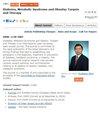血糖分散指数在预测合并急性冠状动脉综合征的糖尿病患者主要不良心血管事件中的价值
IF 2.8
3区 医学
Q3 ENDOCRINOLOGY & METABOLISM
Diabetes, Metabolic Syndrome and Obesity: Targets and Therapy
Pub Date : 2024-09-14
DOI:10.2147/dmso.s469436
引用次数: 0
摘要
目的:本研究旨在评估糖化血红蛋白、空腹血浆葡萄糖和餐后2小时血浆葡萄糖计算得出的血糖分散指数(GDI)在预测合并急性冠脉综合征(ACS)的糖尿病患者12个月内主要不良心血管事件(MACE)方面的预测价值:方法:对2016年1月至2022年7月期间在昆明医科大学第六附属医院心内科住院治疗的3261名ACS糖尿病患者进行回顾性研究。根据纳入和排除标准,研究最终纳入了 512 名患者。研究人员收集了患者的一般信息和实验室检查指标,并对入选患者入院后12个月内发生MACE的情况进行了随访和记录,最后一次随访于2023年7月31日结束。根据 GDI 值从低到高将入组患者分为四组(Q1、Q2、Q3、Q4)。采用Cox比例危险回归分析和Kaplan-Meier生存分析来研究这些组别中发生MACE的相关风险因素,并评估各组别中随着时间推移发生MACE的累积风险:Q1至Q4组发生MACE的入组患者比例分别为10.16%、12.50%、15.63%和16.41%。GDI可独立预测入组患者的MACE风险。与 GDI≤4.21 的患者相比,GDI> 4.21 的患者随着时间的推移发生 MACE 的累积风险要大得多:GDI升高与合并ACS的糖尿病患者MACE风险增加相关,因此可作为评估患者临床预后不良的早期指标。这项研究为血糖变异性监测提供了新的见解,有助于加强糖尿病患者心血管疾病的预防和治疗策略。 关键词:糖尿病;急性冠状动脉综合征;主要不良心血管事件;血糖分散指数;血糖变异性本文章由计算机程序翻译,如有差异,请以英文原文为准。
Value of Glycemic Dispersion Index in Predicting Major Adverse Cardiovascular Events in Diabetic Patients with Concomitant Acute Coronary Syndrome
Aim: This investigation aims to assess the predictive value of the glycemic dispersion index (GDI), calculated by incorporating glycated hemoglobin, fasting plasma glucose, and 2-hour postprandial plasma glucose, in predicting major adverse cardiovascular events (MACE) within a 12-month timeframe for diabetic patients with concomitant acute coronary syndrome (ACS).
Methods: A retrospective study was conducted on 3261 diabetic patients with ACS who were hospitalized in the Department of Cardiology, the Sixth Affiliated Hospital of Kunming Medical University, from January 2016 to July 2022. Based on the inclusion and exclusion criteria, 512 patients were ultimately enrolled in the study. Their general information and laboratory test indicators were collected, and the occurrence of MACE within 12 months after admission was followed up and recorded for the enrolled patients, With the last follow-up having been concluded on July 31, 2023. The enrolled patients were stratified into four groups (Q1, Q2, Q3, Q4) based on their GDI values, from the lowest to the highest. Cox proportional hazards regression analysis and Kaplan-Meier survival analysis were employed to investigate the risk factors associated with MACE occurrence across these groups and to assess the cumulative risk of MACE over time within each group.
Results: The percentages of enrolled patients experiencing MACE in groups Q1 to Q4 were 10.16%, 12.50%, 15.63%, and 16.41%, respectively. GDI independently predicted the hazards for MACE in enrolled patients. The cumulative risk of MACE over time was considerably more significant in those with a GDI> 4.21 than those with a GDI≤ 4.21.
Conclusion: The elevated GDI is correlated with an augmented risk of MACE in diabetic patients with concomitant ACS, thereby serving as an early indicator for assessing the unfavorable clinical prognosis of patients. This study offers novel insights into glycemic variability monitoring, enhancing prevention and treatment strategies for cardiovascular disease in people with diabetes.
Keywords: diabetes, acute coronary syndrome, major adverse cardiovascular events, glycemic dispersion index, glycemic variability
Methods: A retrospective study was conducted on 3261 diabetic patients with ACS who were hospitalized in the Department of Cardiology, the Sixth Affiliated Hospital of Kunming Medical University, from January 2016 to July 2022. Based on the inclusion and exclusion criteria, 512 patients were ultimately enrolled in the study. Their general information and laboratory test indicators were collected, and the occurrence of MACE within 12 months after admission was followed up and recorded for the enrolled patients, With the last follow-up having been concluded on July 31, 2023. The enrolled patients were stratified into four groups (Q1, Q2, Q3, Q4) based on their GDI values, from the lowest to the highest. Cox proportional hazards regression analysis and Kaplan-Meier survival analysis were employed to investigate the risk factors associated with MACE occurrence across these groups and to assess the cumulative risk of MACE over time within each group.
Results: The percentages of enrolled patients experiencing MACE in groups Q1 to Q4 were 10.16%, 12.50%, 15.63%, and 16.41%, respectively. GDI independently predicted the hazards for MACE in enrolled patients. The cumulative risk of MACE over time was considerably more significant in those with a GDI> 4.21 than those with a GDI≤ 4.21.
Conclusion: The elevated GDI is correlated with an augmented risk of MACE in diabetic patients with concomitant ACS, thereby serving as an early indicator for assessing the unfavorable clinical prognosis of patients. This study offers novel insights into glycemic variability monitoring, enhancing prevention and treatment strategies for cardiovascular disease in people with diabetes.
Keywords: diabetes, acute coronary syndrome, major adverse cardiovascular events, glycemic dispersion index, glycemic variability
求助全文
通过发布文献求助,成功后即可免费获取论文全文。
去求助
来源期刊

Diabetes, Metabolic Syndrome and Obesity: Targets and Therapy
Pharmacology, Toxicology and Pharmaceutics-Pharmacology
CiteScore
5.90
自引率
6.10%
发文量
431
审稿时长
16 weeks
期刊介绍:
An international, peer-reviewed, open access, online journal. The journal is committed to the rapid publication of the latest laboratory and clinical findings in the fields of diabetes, metabolic syndrome and obesity research. Original research, review, case reports, hypothesis formation, expert opinion and commentaries are all considered for publication.
 求助内容:
求助内容: 应助结果提醒方式:
应助结果提醒方式:


